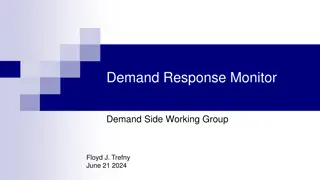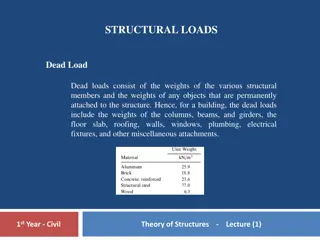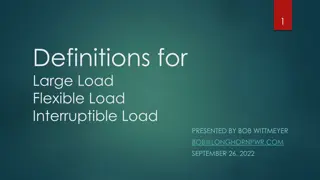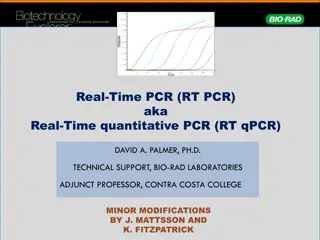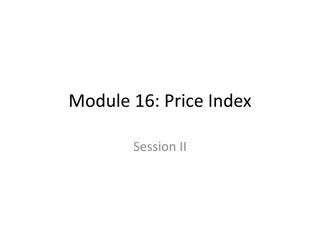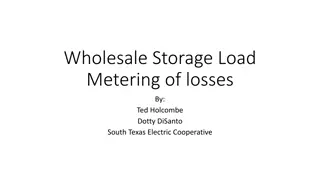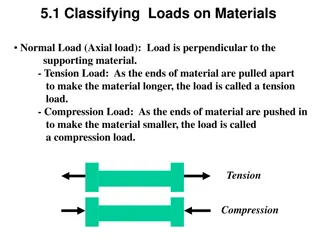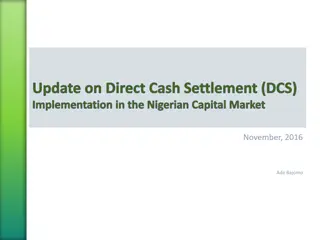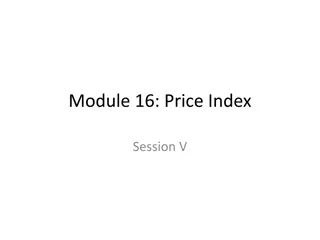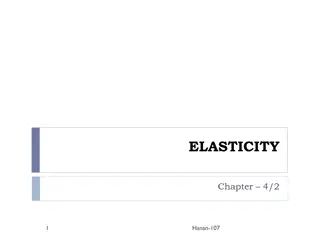Floyd Trefny Proposal for Real-Time Settlement of Price-Sensitive Flexible Loads
The Floyd Trefny proposal aims to enhance real-time settlement for loads responsive to prices but not registered as controllable load resources. It suggests unique pricing based on Load Zone prices, impacting revenue allocation and benefiting responsive loads while possibly increasing costs for others.
Download Presentation

Please find below an Image/Link to download the presentation.
The content on the website is provided AS IS for your information and personal use only. It may not be sold, licensed, or shared on other websites without obtaining consent from the author.If you encounter any issues during the download, it is possible that the publisher has removed the file from their server.
You are allowed to download the files provided on this website for personal or commercial use, subject to the condition that they are used lawfully. All files are the property of their respective owners.
The content on the website is provided AS IS for your information and personal use only. It may not be sold, licensed, or shared on other websites without obtaining consent from the author.
E N D
Presentation Transcript
Issue LFL - 41 Settlement of Price Sensitive Flexible Loads 5/31/23
What is the Concept of the Floyd Trefny Proposal? Improve Real-Time settlement of Load that is responsive to prices but not registered as a Controllable Load Resource. This is Load that does not have a bid to buy in SCED and is not following Base Points but is capable to adjust consumption levels in response to prices a) Still settled using a price based on the Load Zone Price b) Still settled on a 15-minute interval basis. (Continue to use a 15-minute interval price and the 15-minute interval Metered Quantity) c) No change in the 15-minute metered quantity for each Load. No change to Load Ratio Share calculations. d) The 15-minute price for this load would have each SCED interval Load Zone Price weighted by the MWh consumption during the SCED interval as determined using the integrated telemetered MW consumption levels. (The calculated weighting factors that are applied to the SCED prices in the 15-minute interval to determine the 15-minute price.) e) This would have an impact on Real-Time Revenue Neutrality Allocation calculation. 2 ERCOT Public
Additional Information a) All the prices shown in the tables of Floyd s presentation are either a Load Zone price for a 5-minute SCED interval or a Load Zone price for a 15-minute interval? In other words, the proposal does NOT suggest to have a Price Sensitive Flexible Load settled using its nodal price at the bus. The proposal is for each Price Sensitive Flexible Load to have a unique price that is based on the Load Zone price. b) The proposal does NOT change the prices, or the mechanism used to settle (pay) the Resources that provide energy. c) With this proposal: i. the payments to Resources providing energy will not change, ii. charges to Price Sensitive Flexible Loads that have successfully responded to SCED interval prices each SCED interval would be less (compared to what they are charged with today s construct), iii. other Loads will have to pay more (compared to what they are paying with today s construct) and iv. the sum of the differences realized by the Price Sensitive Flexible Loads is uplifted to all Loads based on Load Ratio Share 3 ERCOT Public
The proposal from Floyd needs discussion at other subcommittees a) Impact to other Loads b) Telemetry questions c) What Load is eligible for this new pricing approach? d) What is the registration process? e) Is there a validation process? What is the criteria? f) How many ESIIDs are likely to want this new pricing approach? g) What is the priority to implement this change considering all the other ongoing approved NPRRs and changes? h) And more . 4 ERCOT Public
Appendix 1. https://www.ercot.com/files/docs/2023/04/12/LFLTF-Settlement-of-Price- Responding-Loads-041223.pptx Link to Floyd s 4-12-23 Presentation 2. 3. 4. Load Zone LMPs Load Zone Price Calculation Price Calculation for Settlement Meter for ESR-CLR 5 ERCOT Public
Real-Time Energy Imbalance Payment or Charge at a Load Zone (6.6.32) (2) The payment or charge to each QSE for Energy Imbalance Service at a Load Zone for a given 15-minute Settlement Interval is calculated as follows: RTEIAMT q, p = (-1) * {[RTSPP p * [(SSSK q, p * ) + (DAEP q, p * ) + (RTQQEP q, p * ) (SSSR q, p * ) (DAES q, p * ) (RTQQES q, p * )]] + [RTSPPEWp* (RTMGSOGZ q, p (RTAML q, p RTAMLESRNW q, p))]} 6 ERCOT Public
Load Zone LMPs (section 6.6.1.4) (1) The Load Zone LMPs shall be posted on the ERCOT website. The Load Zone LMP is based on the state-estimated Loads in MW and the Real-Time LMPs at the Electrical Buses included in the Load Zone. The Load Zone LMP for a Load Zone for a SCED interval is calculated as follows: LZLMP y = b (RTLMPb, y * LZWF b, y) For all Load Zones except DC Tie Load Zones: SELb, y/ ( LZWF b, y = b SELb, y) 7 ERCOT Public
Real-Time Settlement Point Price for a Load Zone (section 6.6.1.2 paragraph 2) For all Settlement calculations in which a 15-minute Real-Time Settlement Point Price for a Load Zone is required in order to perform Settlement for a 15-minute quantity that is represented as one value (the integrated value for the 15-minute interval) but varies with each SCED interval within the 15-minute Settlement Interval, an energy-weighted Real- Time Settlement Point Price shall be used and is calculated as follows: b (RTLMPb, y * LZWF b, y) + RTSPPEW = Max [-$251, ( y RTRSVPOR + RTRDP)] For all Load Zones except DC Tie Load Zones: (SELb, y * TLMP y) / [ b (SELb, y * TLMPy)] y LZWF b, y = 8 ERCOT Public
RT Settlement Point Price for a Load Zone (section 6.6.1.2) The 15-minute Load Zone Prices are Load Weighted and SCED duration weighted. The 15-minute Load Zone price is calculated using the State Estimated Load at each bus in the Load Zone (this is the load weighting) and uses the duration of each SCED interval (this it the SCED duration weighting. The picture below is an example of the first 15-minute interval of the hour having four SCED intervals in the first 15- minute interval. Note that: In the picture, the blue lines are when the SCED process sends out base points and SCED LMPs. SCED interval 1 is 3 minutes long (180 seconds) [TLMP1] SCED interval 2 is 4 minutes long (240 seconds) [TLMP2] SCED interval 3 is 6 minutes long (360 seconds) [TLMP3] SCED interval 4 is 2 minutes long (120 seconds) [TLMP4] Total is 15 minutes (900 seconds). See how the SCED intervals that straddle the top of the hour, and the 12:15 mark are handled . 9 ERCOT Public
Use 6.6.3.1 paragraph (3) at the template for the ESIID MW weighted price Where the price for Settlement Meter is determined as follows: RTRMPRESR b = Max [-$251, ( RTRDP)] (RNWFL b, y * RTLMP b, y) + RTRSVPOR + Where the weighting factor for the Electrical Bus associated with the meter is: RNWFL b, y = [Max (0.001, BP r, y) * TLMP y] / [ Max (0.001, BP r, y) * TLMP y] Where: RTRSVPOR = (RNWF y * RTORPA y) RTRDP = y (RNWF y * RTORDPA y) TLMP y/ RNWF y = y TLMP y Instead of Meter Price: ..15-minute price for the ESIID (signed up) Instead of BP: use the MW average telemetered consumption for the SCED interval Instead of RTLMPb,y .. use the LZLMPy for the mapped zone 10 ERCOT Public


